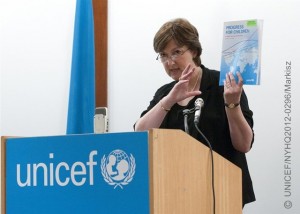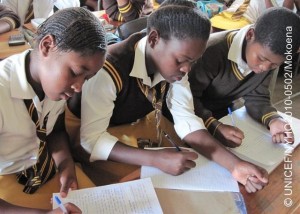聯合國兒童基金會《兒童進展報告》 全球數百萬青少年發展受壓 非洲情況尤其嚴峻
2012-04-24

紐約/香港,2012年4月24日——過去20年,教育及公共衞生項目上的進步,改善了不少青少年的生活。但根據聯合國兒童基金會(UNICEF)最新發表的《兒童進展報告:青少年報告》(Progress for Children: A report card on adolescents)指,在世界各地,仍有眾多青少年的需要仍然備受忽略,促使每年多逾100萬名青少年喪生、數以千萬計的青少年失學。
舉例說,報告指出,縱觀全球,撒哈拉以南的非洲地區是現今青少年發展最惡劣的地區。區內青少年人口不斷增長,預計到2050年,該區將成為全球青少年人口最高的地方。然而,現時當地兒童的小學畢業率僅得五成,青年就業率亦屬偏低。
《兒童進展報告:青少年報告》亦警告,全球合共多達12億名青少年(根據聯合國的定義,青少年是指介乎10至19歲的人士),由於各地發展不均,遂衍生出種種棘手問題。
「貧窮、社會地位低、性別不平等或肢體殘障,導致數以百萬計的青少年無法平等獲取優質教育、醫療服務及參與社會事務的權利。」UNICEF副執行主任Geeta Rao Gupta女士表示:「這份全面的報告有助我們找出最貧困、處於最弱勢的青少年,認清他們問題所在。大家是時候正視他們的需要,決不能再置之不理。」
![(Left-right) Azara Mohammed, 14, and Humu Baba, 13, visit a guinea-worm containment centre in the town of Savelugu, capital of Savelugu-Nanton District in Northern Region. Both children were previously infected with guinea-worm disease, a painful and debilitating infection caused by a parasite ingested through drinking contaminated water. Children under 16, who are more likely to play in or drink from infected water sources, are most affected. [#1 IN SEQUENCE OF TWO] In September 2008 in Ghana, economic growth and government reforms continue to improve the lives of children and families. The country is on track to achieve several United Nations Millennium Development Goals (MDGs). However, progress is uneven. The northern regions, which account for half of the countrys population living below the poverty line, are the most impoverished, and there are wide regional and rural/urban disparities in child and maternal mortality. And while 78 per cent of the entire population has access to improved drinking water sources and 60.7 per cent have access to improved sanitation, the north lags well behind these percentages. Working with the Government and other partners, UNICEF supports health, nutrition, education and protection interventions, as well as a range of integrated water, sanitation and hygiene (WASH) interventions, including to eradicate guinea-worm disease in endemic districts.](/wp-content/uploads/2015/12/0424_PRC12_boys-300x214.jpg)    |
年少結婚產子有礙少女身心發展 報告亦提出,各界必需投放更多資源,改善青少年各方面的生活及福利,以至他們的生存所需。現時每年有140萬名青少年死於交通意外、妊娠或分娩併發症、自殺、愛滋病和暴力事件等事故。在某些拉丁美洲國家,與道路交通傷亡及自殺相比,有更多的少男是死於兇殺案;在非洲,妊娠和分娩併發症則是15至19歲少女的頭號殺手。 而兒童由踏入青少年階段開始,他們面對的最大威脅,亦隨之由疾病及營養不良問題,轉化為暴力問題,當中少女尤其容易受婚姻暴力所傷害。根據一項在剛果民主共和國進行的調查,7成年齡介乎15至19歲的受訪已婚少女表示,她們曾遭受過現任或前任伴侶暴力對待。 更甚者,青少年,特別是少女,很多時都被迫提早放棄童年,擔起成年人的責任。這不但扼殺了他們學習及成長的機會,更置他們的健康與人身安全於凶險。 報告指出,在中國以外的發展中國家,多逾1/3年齡介乎20至24歲的婦女,早在18歲時已結婚或同居,而當中約1/3人的結婚年齡更早至15歲。至於,拉丁美洲、加勒比及撒哈拉以南的非洲區內的青少年生育率亦處於甚高水平。在尼日爾,多達半數20至24歲的少女,18歲前已經產子。 中學入學率持續偏低 在教育發展方面,全球小學入學率雖已平均達到90%,不少國家更正努力擴展中學教育,然發展中國家的中學入學率依然處於低水平。其中尤以非洲及亞洲情況最為嚴重,當地許多中學適齡學童仍然就讀小學,在撒哈拉以南的非洲地區,中學入學率更位列全球最尾。 目前全球約有7,100萬名中學適齡學童失學,另有1.2億名15至24歲的青少年屬文盲,他們大部分集中在南亞和撒哈拉以南的非洲地區。 |
年輕人同時是帶動社區轉變的骨幹,相關項目及政策除了要保護兒童及青少年外,還要給予他們發展潛能的機會,讓他們能夠巧用自身的想像力、創意和活力,解決種種疑難。


按此閱讀報告全文 (只提供英文版本) 按此了解全球青少年概況









